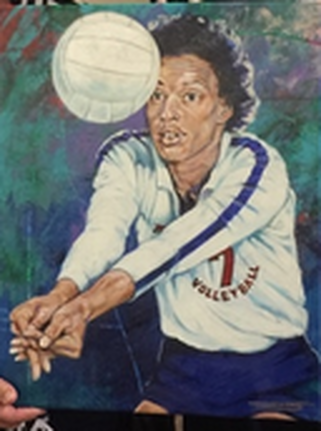Legendary names like Flo Hyman, Burt DeGroot, Liz Masakayan and Elaina Oden spice the Southern California Indoor Volleyball Hall of Fame list of 27 preliminary nominees who will be pared down to 15 and inducted on May 6, 2018.
All-time great Houston teammates blazed path for volleyball’s next generation
By BRICE CHERRY [email protected]
Back when she attended the University of Houston, Flo Hyman took a “Coaching Volleyball” course overseen by her own coach, Ruth Nelson.
Nelson gave Hyman a ‘C’ in the class.
“We laughed about it a lot,” Nelson said. “She couldn’t believe she got a C.”
That’s because as a volleyball player — and really as a person — Hyman was a straight-A performer.
The same could be said of Rita Buck-Crockett, Hyman’s friend and former teammate at Houston. No matter what volleyball coach or expert you ask, the consensus is that Hyman and Buck-Crockett both rank among the game’s all-time great players.
So the fact that the duo are the first volleyball players ever to earn induction into the Texas Sports Hall of Fame seems only fitting. It’s kind of like when Babe Ruth and Ty Cobb were inducted into the National Baseball Hall of Fame.
They’re the elite.
“Flo hit the ball as hard as anyone, but she was equally graceful and nimble,” Nelson said. “Rita had the ability to catch on and learn new things so quickly. She was one of the finest athletes I ever coached, and she could catch on to any aspect of the game as soon as she was instructed. They were both tremendous.”
As a young girl growing up in Inglewood, Calif., Hyman was always unnaturally tall for her age. Her sister, Bobbi Bedford, recalled Hyman being 5-foot-9 in the third grade.
Everyone expected her to play basketball, but Hyman was instead attracted to that other sport often played by taller girls, volleyball.
“My sister hated basketball, but she loved volleyball. It’s what she lived for,” Bedford said. “When she got started, it turned her life around and she became a different person. Later, young black girls used to come up to her and tell her, ‘You made it possible for me to play volleyball,’ and they damned well told the truth.”
Hyman was self-conscious about her height growing up, but her mother, Warrenne, instructed her to be confident and proud. Hyman grew to be 6-foot-5 and developed into one of the top volleyball players in the country, with a spike that was once clocked at 110 miles per hour.
She was so advanced for her age that she was invited to join the U.S. National team in 1974, as a high school player. It was there she met Nelson, who also played for the national team in addition to coaching at Houston. Nelson offered Hyman a full scholarship, and she became Houston’s first female scholarship athlete. However, Hyman declined to accept the full cost of the scholarship so other athletes could benefit as well, Nelson said.
Despite Hyman’s prodigious size and power, Nelson installed her as Houston’s setter. “People wondered why I just didn’t let her hit it all the time, but the reason I put her at setter is so she could learn the game,” Nelson said. “Remember, she was on the national team, too. At setter, you’re responsible for so much. You’ve got to play defense, you help run the attack. It really helped her learn the overall game.”
Hyman possessed a playful, fun-loving personality, and she used it to have fun with her coach.
“She knew what she needed to work on, but she was so funny,” Nelson said. “She said, ‘You know, Ms. Nelson, if I’m so good, why do I have to practice?’ And I’d tell her, ‘Flo, it’s obvious you’re one of the best players in the world. You know how you got that way? You practiced.’”
Hyman dominated matches at Houston and was named an All-American three times. She skipped her senior year to devote more time to Team USA, and then ventured to Japan to play professionally.
She had first visited Japan while with the Lady Cougars, and the people there fell in love with Hyman right away. During Hyman’s pro career with the Daiei women’s squad, she also began acting and modeling. In 1985, she appeared in a movie entitled “Order of the Black Eagle” in which she played a knife-wielding character named Spike.
“They just loved her in Japan,” Nelson said. “They taught her to water-ski. They would come up to her and measure their feet against hers. At the time, Japan had one of the highest participation rates in volleyball in the world.”
In January of 1986, Hyman and her Daiei team were playing a game against Hitachi in Matuse City, Japan. While sitting on the bench during a substitution, Hyman collapsed and later died. What was initially thought to be a heart attack was later found to be a symptom of Marfan’s Syndrome, which had previously gone undetected.
Hyman was mourned both in the U.S. and abroad. In Japan, billboards paid tribute to her legacy. Her funeral in California drew more than 500 friends and family. “I’ll always remember her smile,” Buck-Crockett said. “The woman had the most amazing smile. She was an ambassador for the game in every sense of the word.” Unlike Hyman, Buck-Crockett pursued a variety of athletic endeavors as a child. She was raised in a poor neighborhood in San Antonio, and she recognized that athletics – whether basketball, track or volleyball – might provide an escape.
“My dad was a good athlete, and by nature I was a natural athlete,” Buck-Crockett said. “But I also came from a very poor background and I knew my athleticism could be my way out. So I took advantage of that, used it to find satisfaction.”
She also found a college scholarship. She initially played volleyball and basketball at San Antonio Junior College before transferring to North Texas. But at the time the volleyball hub of Texas was located at Houston, and she transferred again, joining up with Nelson and Hyman for the Lady Cougars. While in Houston, she elevated to new heights — literally. “Rita could always jump, but she gained six inches on her vertical leap,” Nelson said. “She went from 36 inches to 42 inches, and was one of the best jumpers in the world.”
Buck-Crockett was selected to the U.S. Olympic team in 1980, but wasn’t able to compete after the United States boycotted the games in Moscow.
Fortunately, four years later, she finally was able to soak in the entire Olympic experience in Los Angeles.
“I don’t even know how I can put that experience into words,” said Buck-Crockett, who won a silver medal at the Games. “The biggest thing is that everyone on that team became sisters. We’re still very close today. We call each other, and we know that if any of us needed anything, we’d be there for one another.”
Buck-Crockett ended up playing professionally for 16 years, on teams in Japan, Switzerland and Italy. In Switzerland, she met her future husband. For a girl who grew up in poverty, seeing the world while being paid to play a sport she loved proved a little mind-blowing.
Today, Buck-Crockett works as the head coach of the Florida International University’s beach and indoor volleyball teams. She said she gained an understanding and appreciation for coaching the deeper she traveled in her pro career, and she always wanted to be an advocate for minorities striving for an education.
“I know what they feel,” Buck-Crockett said. “It’s never a nice feeling when you’re made to feel inferior because of what you have. You’re born into what you’re born into, but it’s up to you to make something better.”
During Buck-Crockett’s time as a pro in Japan, she reunited with Hyman, as the two became teammates again. She called Hyman “the big sister she never had” and was with her at the game on the day she died.
Buck-Crockett said that she found herself overcome with emotion when she received the call from Texas Sports Hall of Fame vice president Jay Black that she’d been voted as an inductee. The fact that her old volleyball “sister” Hyman was joining her made it all the more special. “It’s awesome,” Buck-Crockett said. “I mean, we’re making history together again.
“I just really wish she was here to be part of the ceremony, because she deserves that.”
- Texas Sports Hall of Fame photo
Former University of Houston volleyball star Flo Hyman’s spike was once measured at 110 mph.
By BRICE CHERRY [email protected]
Back when she attended the University of Houston, Flo Hyman took a “Coaching Volleyball” course overseen by her own coach, Ruth Nelson.
Nelson gave Hyman a ‘C’ in the class.
“We laughed about it a lot,” Nelson said. “She couldn’t believe she got a C.”
That’s because as a volleyball player — and really as a person — Hyman was a straight-A performer.
The same could be said of Rita Buck-Crockett, Hyman’s friend and former teammate at Houston. No matter what volleyball coach or expert you ask, the consensus is that Hyman and Buck-Crockett both rank among the game’s all-time great players.
So the fact that the duo are the first volleyball players ever to earn induction into the Texas Sports Hall of Fame seems only fitting. It’s kind of like when Babe Ruth and Ty Cobb were inducted into the National Baseball Hall of Fame.
They’re the elite.
“Flo hit the ball as hard as anyone, but she was equally graceful and nimble,” Nelson said. “Rita had the ability to catch on and learn new things so quickly. She was one of the finest athletes I ever coached, and she could catch on to any aspect of the game as soon as she was instructed. They were both tremendous.”
As a young girl growing up in Inglewood, Calif., Hyman was always unnaturally tall for her age. Her sister, Bobbi Bedford, recalled Hyman being 5-foot-9 in the third grade.
Everyone expected her to play basketball, but Hyman was instead attracted to that other sport often played by taller girls, volleyball.
“My sister hated basketball, but she loved volleyball. It’s what she lived for,” Bedford said. “When she got started, it turned her life around and she became a different person. Later, young black girls used to come up to her and tell her, ‘You made it possible for me to play volleyball,’ and they damned well told the truth.”
Hyman was self-conscious about her height growing up, but her mother, Warrenne, instructed her to be confident and proud. Hyman grew to be 6-foot-5 and developed into one of the top volleyball players in the country, with a spike that was once clocked at 110 miles per hour.
She was so advanced for her age that she was invited to join the U.S. National team in 1974, as a high school player. It was there she met Nelson, who also played for the national team in addition to coaching at Houston. Nelson offered Hyman a full scholarship, and she became Houston’s first female scholarship athlete. However, Hyman declined to accept the full cost of the scholarship so other athletes could benefit as well, Nelson said.
Despite Hyman’s prodigious size and power, Nelson installed her as Houston’s setter. “People wondered why I just didn’t let her hit it all the time, but the reason I put her at setter is so she could learn the game,” Nelson said. “Remember, she was on the national team, too. At setter, you’re responsible for so much. You’ve got to play defense, you help run the attack. It really helped her learn the overall game.”
Hyman possessed a playful, fun-loving personality, and she used it to have fun with her coach.
“She knew what she needed to work on, but she was so funny,” Nelson said. “She said, ‘You know, Ms. Nelson, if I’m so good, why do I have to practice?’ And I’d tell her, ‘Flo, it’s obvious you’re one of the best players in the world. You know how you got that way? You practiced.’”
Hyman dominated matches at Houston and was named an All-American three times. She skipped her senior year to devote more time to Team USA, and then ventured to Japan to play professionally.
She had first visited Japan while with the Lady Cougars, and the people there fell in love with Hyman right away. During Hyman’s pro career with the Daiei women’s squad, she also began acting and modeling. In 1985, she appeared in a movie entitled “Order of the Black Eagle” in which she played a knife-wielding character named Spike.
“They just loved her in Japan,” Nelson said. “They taught her to water-ski. They would come up to her and measure their feet against hers. At the time, Japan had one of the highest participation rates in volleyball in the world.”
In January of 1986, Hyman and her Daiei team were playing a game against Hitachi in Matuse City, Japan. While sitting on the bench during a substitution, Hyman collapsed and later died. What was initially thought to be a heart attack was later found to be a symptom of Marfan’s Syndrome, which had previously gone undetected.
Hyman was mourned both in the U.S. and abroad. In Japan, billboards paid tribute to her legacy. Her funeral in California drew more than 500 friends and family. “I’ll always remember her smile,” Buck-Crockett said. “The woman had the most amazing smile. She was an ambassador for the game in every sense of the word.” Unlike Hyman, Buck-Crockett pursued a variety of athletic endeavors as a child. She was raised in a poor neighborhood in San Antonio, and she recognized that athletics – whether basketball, track or volleyball – might provide an escape.
“My dad was a good athlete, and by nature I was a natural athlete,” Buck-Crockett said. “But I also came from a very poor background and I knew my athleticism could be my way out. So I took advantage of that, used it to find satisfaction.”
She also found a college scholarship. She initially played volleyball and basketball at San Antonio Junior College before transferring to North Texas. But at the time the volleyball hub of Texas was located at Houston, and she transferred again, joining up with Nelson and Hyman for the Lady Cougars. While in Houston, she elevated to new heights — literally. “Rita could always jump, but she gained six inches on her vertical leap,” Nelson said. “She went from 36 inches to 42 inches, and was one of the best jumpers in the world.”
Buck-Crockett was selected to the U.S. Olympic team in 1980, but wasn’t able to compete after the United States boycotted the games in Moscow.
Fortunately, four years later, she finally was able to soak in the entire Olympic experience in Los Angeles.
“I don’t even know how I can put that experience into words,” said Buck-Crockett, who won a silver medal at the Games. “The biggest thing is that everyone on that team became sisters. We’re still very close today. We call each other, and we know that if any of us needed anything, we’d be there for one another.”
Buck-Crockett ended up playing professionally for 16 years, on teams in Japan, Switzerland and Italy. In Switzerland, she met her future husband. For a girl who grew up in poverty, seeing the world while being paid to play a sport she loved proved a little mind-blowing.
Today, Buck-Crockett works as the head coach of the Florida International University’s beach and indoor volleyball teams. She said she gained an understanding and appreciation for coaching the deeper she traveled in her pro career, and she always wanted to be an advocate for minorities striving for an education.
“I know what they feel,” Buck-Crockett said. “It’s never a nice feeling when you’re made to feel inferior because of what you have. You’re born into what you’re born into, but it’s up to you to make something better.”
During Buck-Crockett’s time as a pro in Japan, she reunited with Hyman, as the two became teammates again. She called Hyman “the big sister she never had” and was with her at the game on the day she died.
Buck-Crockett said that she found herself overcome with emotion when she received the call from Texas Sports Hall of Fame vice president Jay Black that she’d been voted as an inductee. The fact that her old volleyball “sister” Hyman was joining her made it all the more special. “It’s awesome,” Buck-Crockett said. “I mean, we’re making history together again.
“I just really wish she was here to be part of the ceremony, because she deserves that.”
©2007-2019 brvc, LLC. All Rights Reserved.
All photos / logos / name and image on all pages of this site may NOT be used without WRITTEN permission by brvc, LLC
A special thank you to USA Volleyball for sharing USA photos of Flo Hyman


